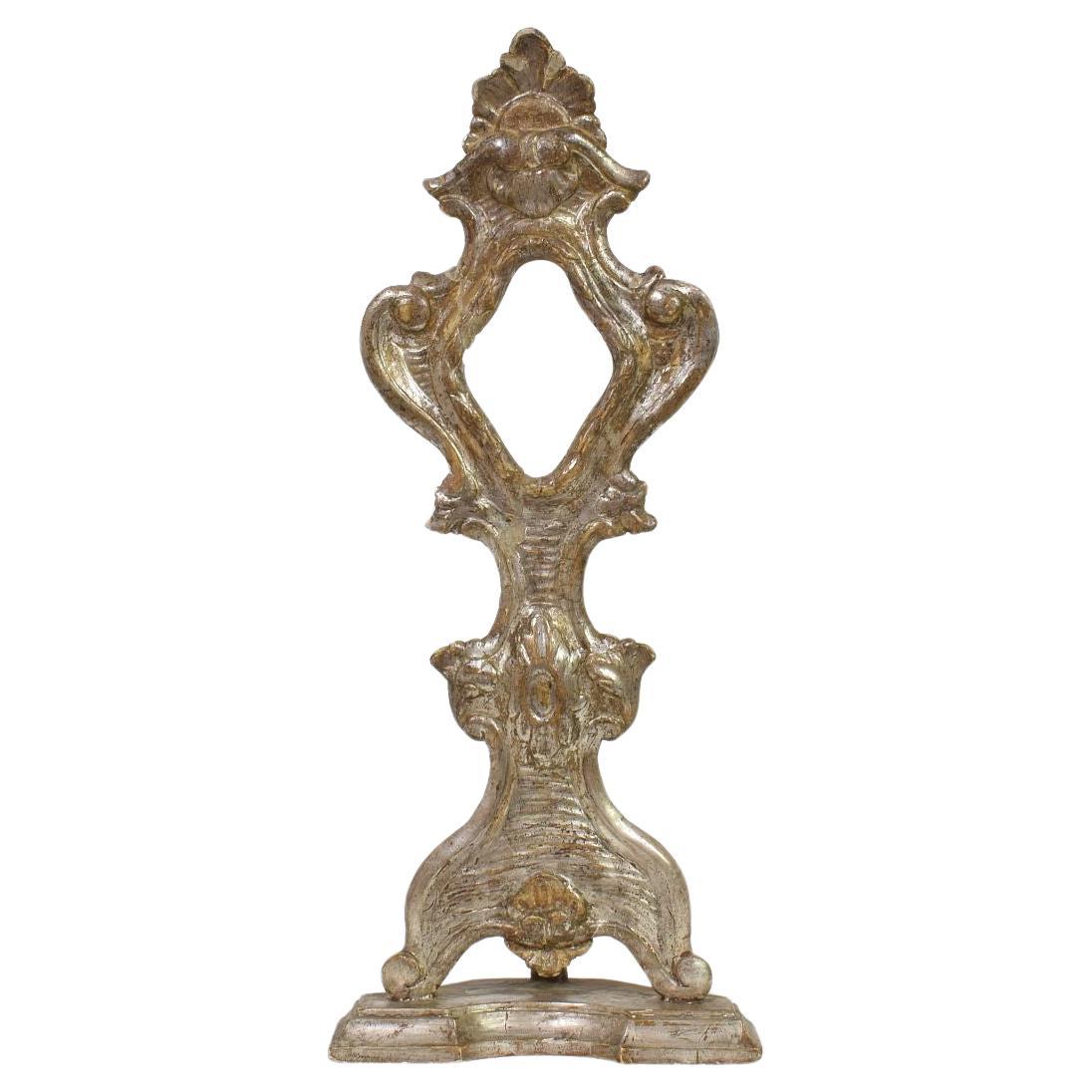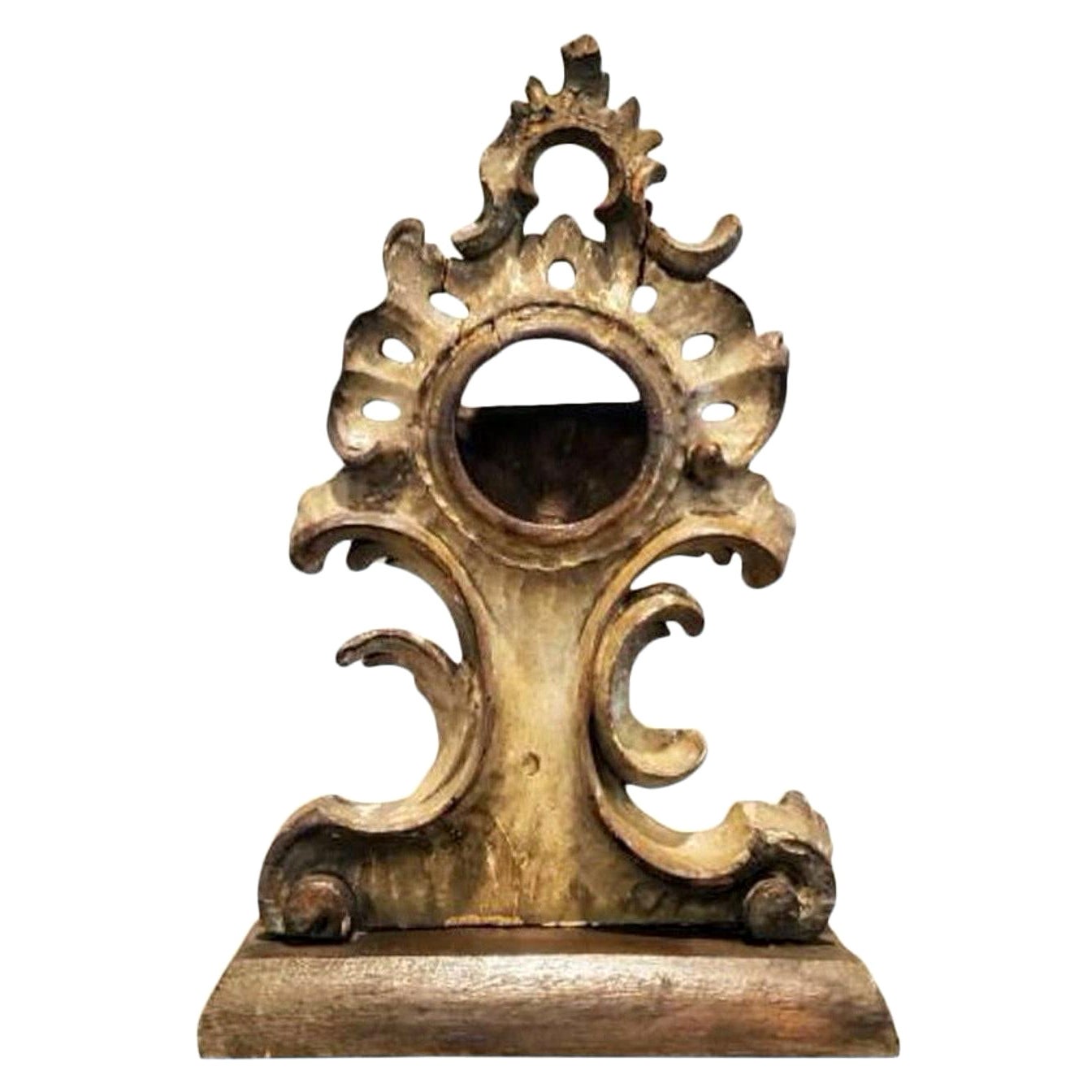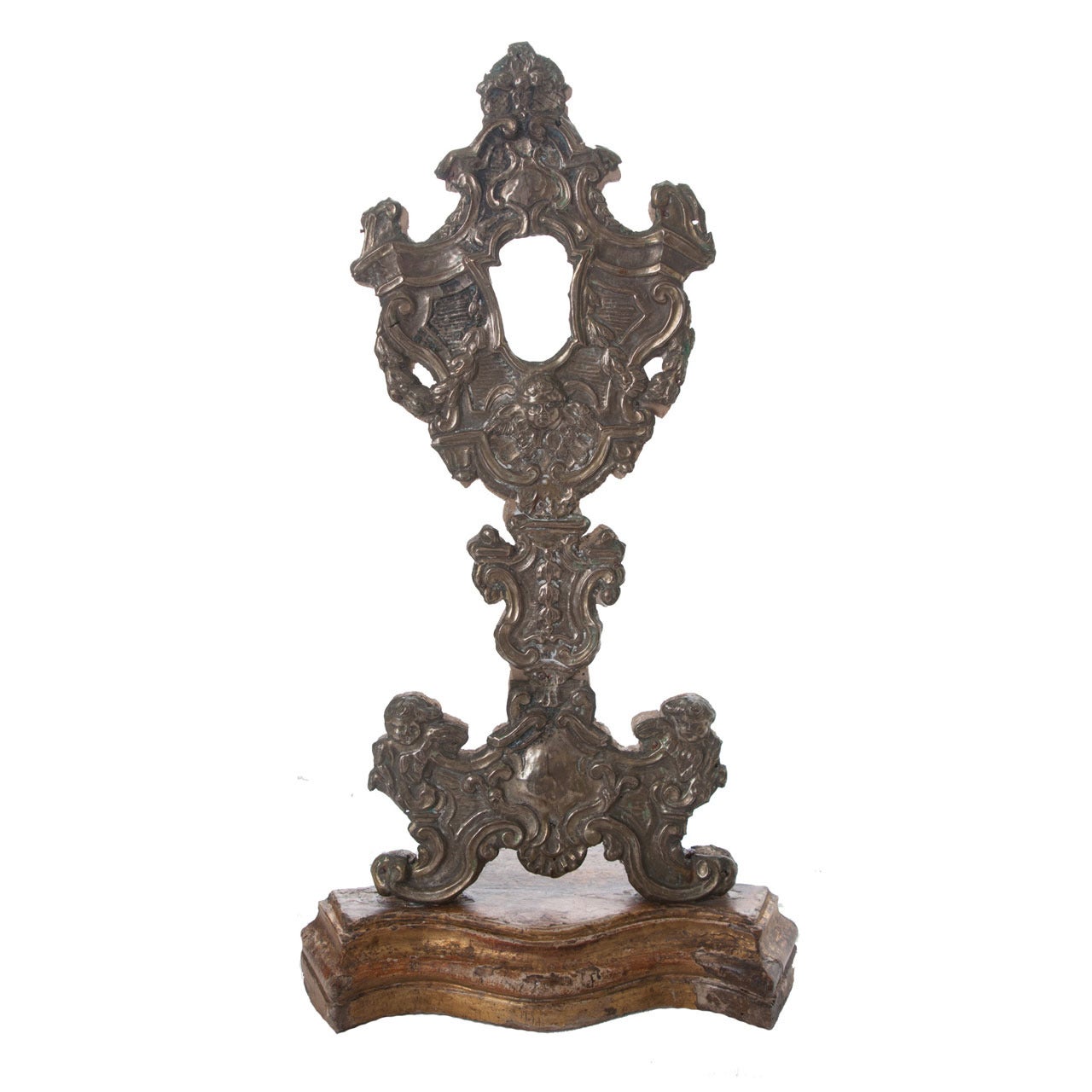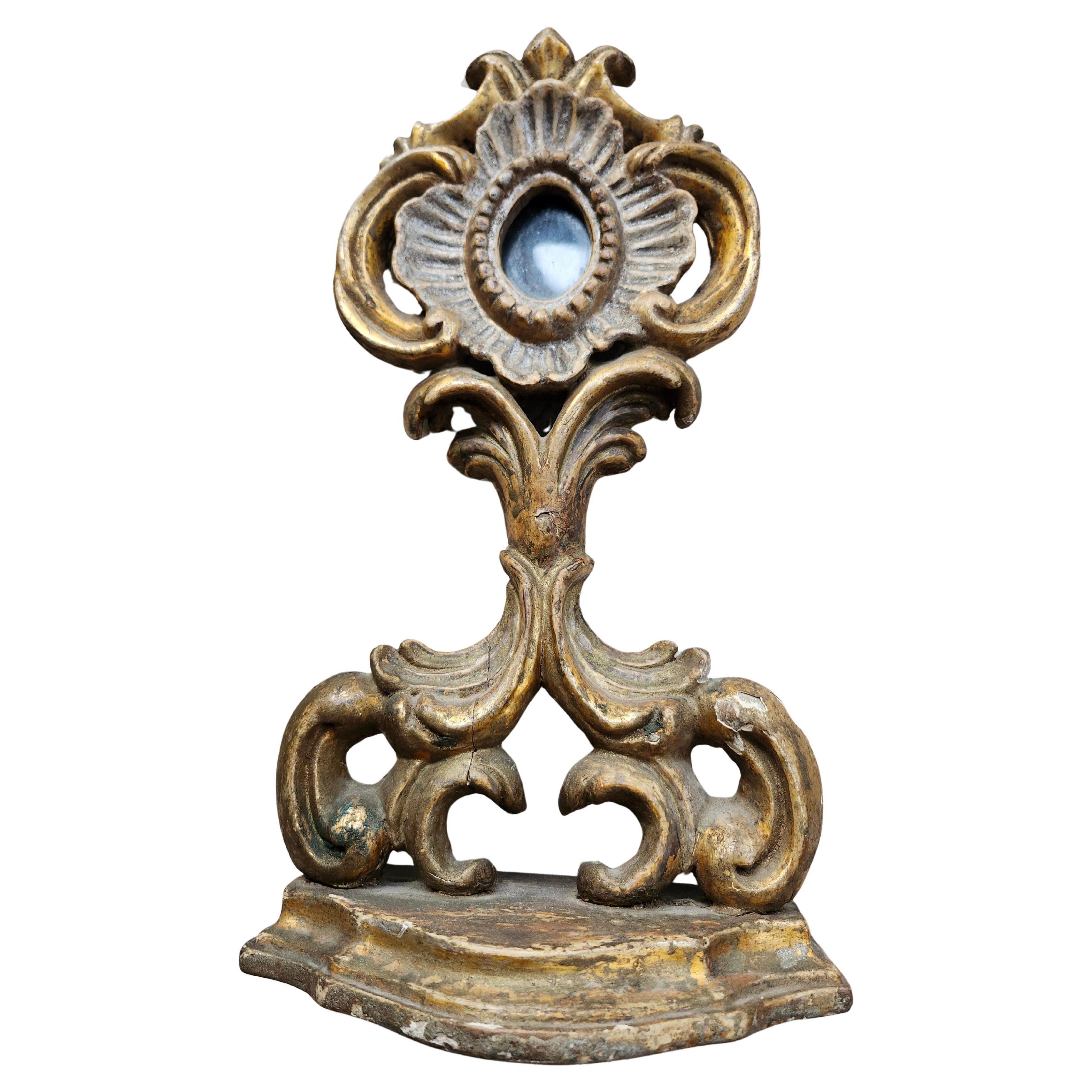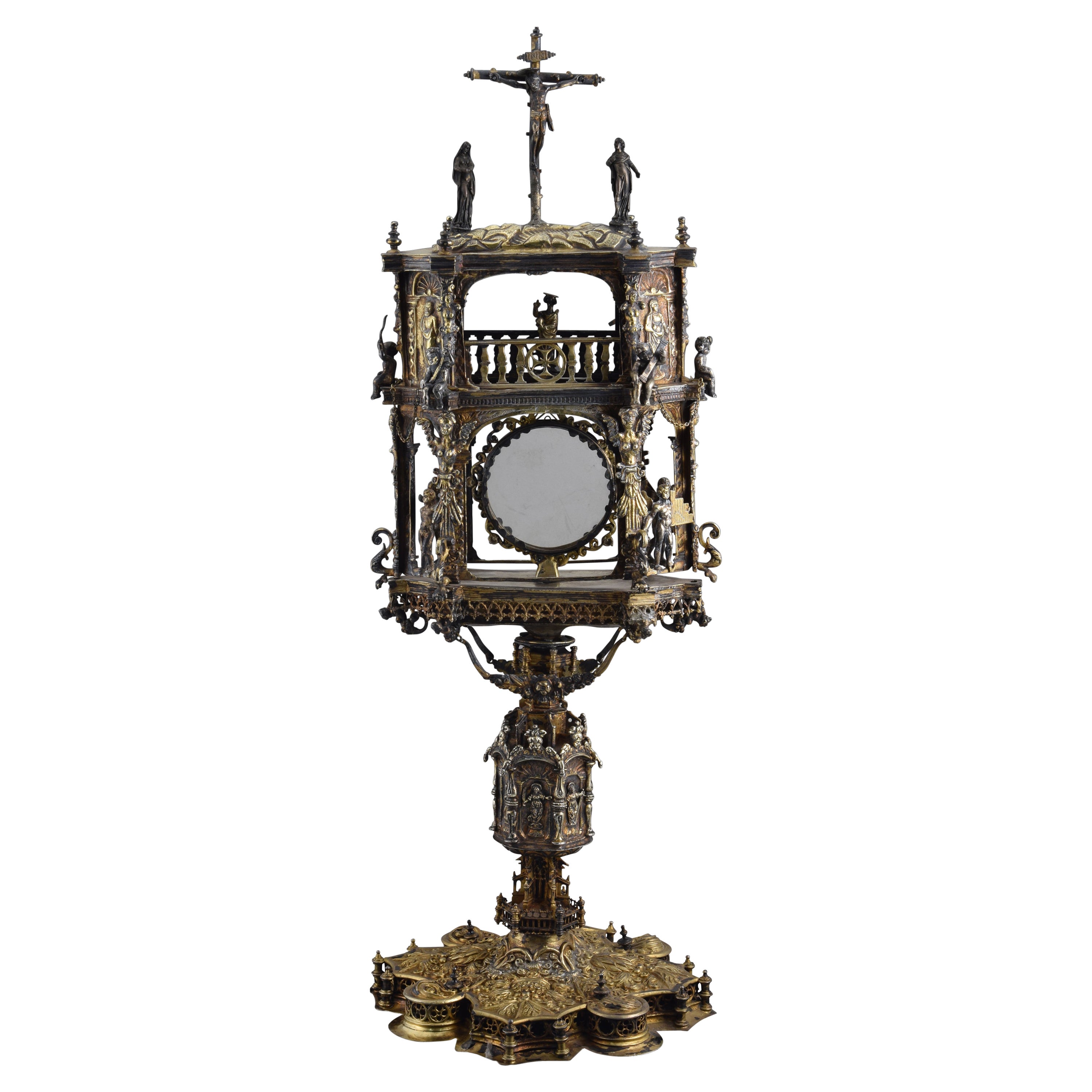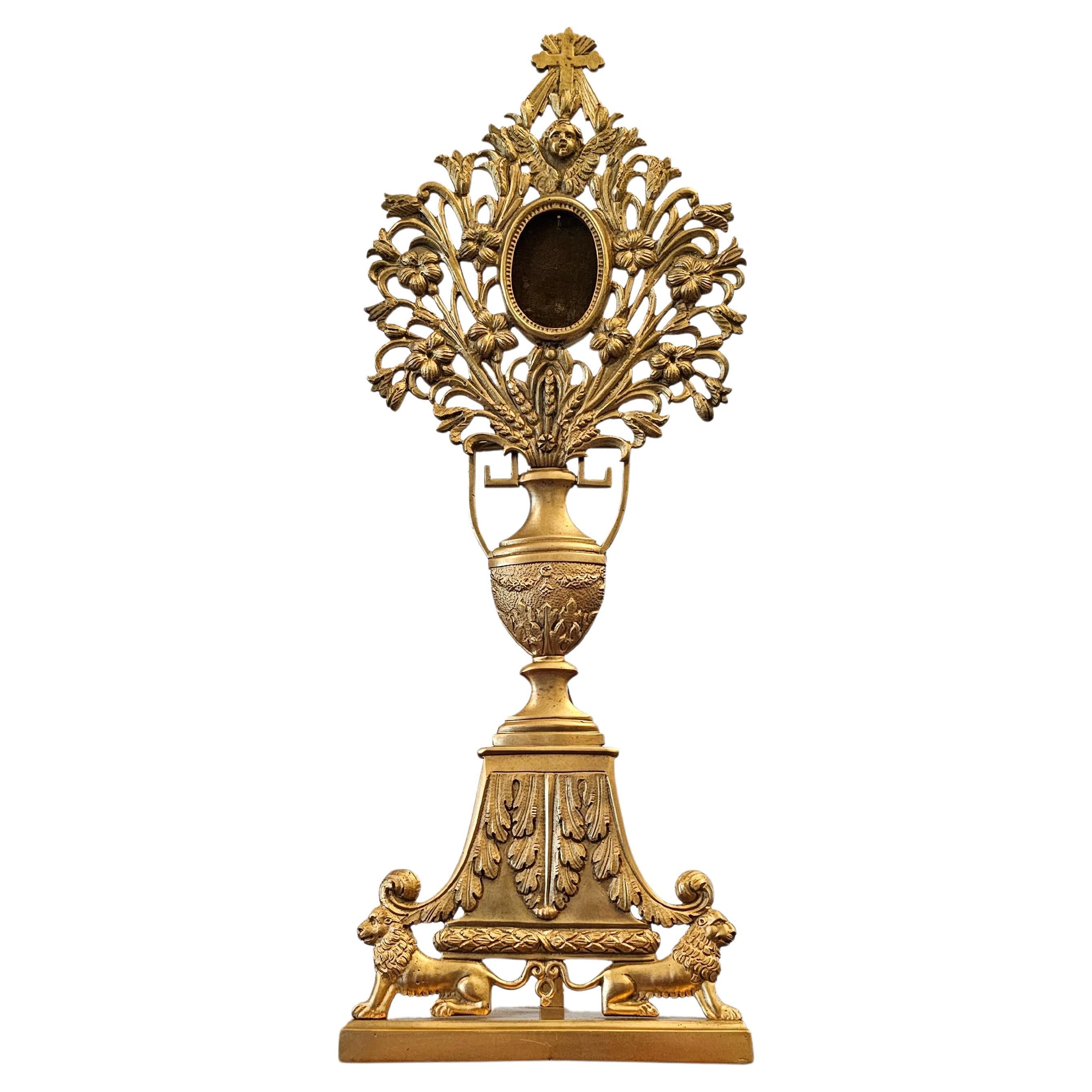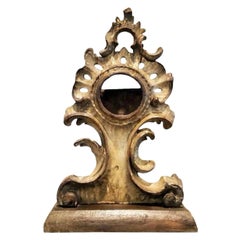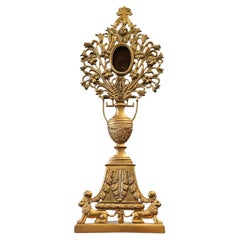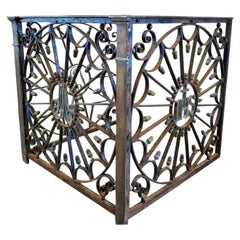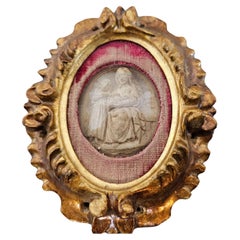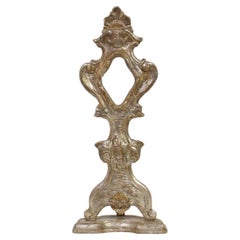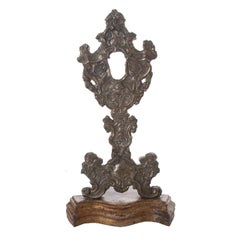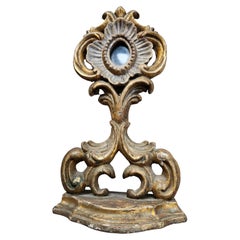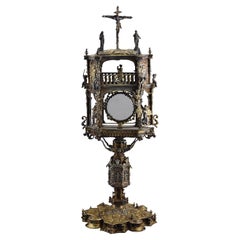Items Similar to 18th/19th Century Italian Baroque Silvered Metal Altar Monstrance Reliquary
Want more images or videos?
Request additional images or videos from the seller
1 of 19
18th/19th Century Italian Baroque Silvered Metal Altar Monstrance Reliquary
$2,250
£1,708.16
€1,953.77
CA$3,143.58
A$3,496.34
CHF 1,825.68
MX$42,546.78
NOK 23,316.74
SEK 21,866.99
DKK 14,581.75
Shipping
Retrieving quote...The 1stDibs Promise:
Authenticity Guarantee,
Money-Back Guarantee,
24-Hour Cancellation
About the Item
A stunning antique Italian Baroque style silvered metal gilded wood monstrance reliquary. circa 1770-1820
Handmade in Italy in the late 18th / early 19th century, commissioned by the church to display an important religious relic, sculptural painted wood form, mounted with decorative silver repousse metal facing, open oval window where the philatory relic was once housed, rising on a gold gilt painted shaped plinth base.
Dimensions: (approx)
17" High, 8" Wide, 5" Deep, 1.25lbs
History:
Reliquaries (also referred to as a shrine or châsse in French), are containers used to protect and display relics. A portable reliquary may be called a fereter, and a chapel in which it is housed a feretory. A monstrance, also known as an ostensorium (or an ostensory), is a vessel used in Roman Catholic, Old Catholic, High Church Lutheran and Anglican churches for the display on an altar of some object of piety, such as the consecrated Eucharistic host during Eucharistic adoration or Benediction of the Blessed Sacrament. It is also used as reliquary for the public display of relics of some saints.
The use of reliquaries became an important part of Christian practices from at least the 4th century, initially in the Eastern Churches, which adopted the practice of moving and dividing the bodies of saints much earlier than the West, probably in part because the new capital of Constantinople, unlike Rome, lacked buried saints. Relics are venerated in the Oriental Orthodox, Eastern Orthodox, Roman Catholic and some Anglican Churches. Reliquaries provide a means of protecting and displaying relics. While frequently taking the form of caskets, they range in size from simple pendants or rings to very elaborate ossuaries.
The relics were enshrined in containers crafted of or covered with gold, silver, gems, and enamel. These objects constituted a important form of artistic production across Europe and Byzantium throughout the Middle Ages.
Many were designed with portability in mind, often being exhibited in public or carried in procession on the saint's feast day or on other holy days. Pilgrimages often centered on the veneration of relics. The faithful often venerate relics by bowing before the reliquary or kissing it; those churches which observe the veneration of relics distinguish between the honor given to the saints and the worship that is due to God alone.
Sixteenth-century reformers such as Martin Luther opposed the use of relics since many had no proof of historical authenticity and objected to a cult of saints. Many reliquaries, particularly in northern Europe, were destroyed by Calvinists or Calvinist sympathizers during the Reformation, being melted down or pulled apart to recover precious metals and gems. Nonetheless, the use and manufacture of reliquaries continue to this day, especially in Roman Catholic and Orthodox Christian countries. Post-Reformation reliquaries have tended to take the form of glass-sided caskets to display relics such as the bodies of saints.Relics of the True Cross became very popular from the 9th century onward and were housed in magnificent gold and silver cross-shaped reliquaries decorated with enamels and precious stones. From about the end of the 10th century, reliquaries in the shape of the relics they housed also became popular; hence, for instance, the skull of Pope Alexander I was housed in a head-shaped reliquary.
Relics play a major role in the consecration of a church. The consecrating bishop will place the relics on a diskos (paten) in a church near the church that is to be consecrated, they will then be taken in a cross procession to the new church, carried three times around the new structure and then placed in the Holy Table (altar) as part of the consecration service.
Many tales of miracles and other marvels have been attributed to relics beginning in the early centuries of the church.
- Dimensions:Height: 17 in (43.18 cm)Width: 8 in (20.32 cm)Depth: 5 in (12.7 cm)
- Style:Baroque (Of the Period)
- Materials and Techniques:
- Place of Origin:
- Period:
- Date of Manufacture:circa 1770-1820
- Condition:Wear consistent with age and use. Excellent original antique condition with nicely aged warm patina.
- Seller Location:Forney, TX
- Reference Number:1stDibs: LU5977233648672
About the Seller
4.8
Platinum Seller
Premium sellers with a 4.7+ rating and 24-hour response times
Established in 2013
1stDibs seller since 2021
293 sales on 1stDibs
Typical response time: <1 hour
- ShippingRetrieving quote...Shipping from: Forney, TX
- Return Policy
Authenticity Guarantee
In the unlikely event there’s an issue with an item’s authenticity, contact us within 1 year for a full refund. DetailsMoney-Back Guarantee
If your item is not as described, is damaged in transit, or does not arrive, contact us within 7 days for a full refund. Details24-Hour Cancellation
You have a 24-hour grace period in which to reconsider your purchase, with no questions asked.Vetted Professional Sellers
Our world-class sellers must adhere to strict standards for service and quality, maintaining the integrity of our listings.Price-Match Guarantee
If you find that a seller listed the same item for a lower price elsewhere, we’ll match it.Trusted Global Delivery
Our best-in-class carrier network provides specialized shipping options worldwide, including custom delivery.More From This Seller
View AllImportant Early 18th Century Italian Carved Monstrance Reliquary Tabernacle
Located in Forney, TX
Important and historic, acquired from the estate of legendary American businessman, the late T. Boone Pickens, we're proud to offer this exceptional carved giltwood reliquary - monstrance from the early 18th century.
Elaborately hand carved in period Rococo - Rocaille taste, with superb scrollwork, openwork, fanciful acanthus leaf and shell, ornate detailing, polychrome painted warm pastel colors, now beautifully distressed, muted tones, with remnants of gold gilded accents.
Pieces such as this were used in early churches for convenient exhibition or public display of some object of piety and other important religious relics...
Category
Antique Early 18th Century Italian Rococo Religious Items
Materials
Giltwood
Fine 19th Century European Gilt Bronze Ormolu Monstrance Reliquary
Located in Forney, TX
A scarce fine quality neoclassical Empire style vasiform gilt bronze ormolu church religious relic altar monstrance reliquary.
Exquisitely hand-crafted in Continental Europe in the second half of the 19th century, most likely French Napoleon III Period (1852-1870), having a fanned cross crest, above winged angel mask, central oval display...
Category
Antique 19th Century European Empire Sculptures and Carvings
Materials
Bronze, Ormolu
19th Century French Ecclesiastical Iron & Bronze Altar Rail
Located in Forney, TX
A rare and magnificent architectural ecclesiastical iron and bronze altar railing. Created in France in the 19th century, commissioned for a Victorian er...
Category
Antique 19th Century French Gothic Revival Religious Items
Materials
Bronze, Iron
Antique Italian Religious Giltwood Reliquary Relief Carved Sculpture
Located in Forney, TX
A rare antique Italian giltwood framed reliquary. 18th/19th century, hand carved giltwood frame housing an exceptional relief carving, d...
Category
Antique Early 19th Century Italian Baroque Religious Items
Materials
Bone, Giltwood
Antique Medieval European Castle Gothic Forged Iron Processional on Stand
Located in Forney, TX
A spectacular early European castle altar processional / torchiere stand. circa 1730 or earlier.
Born in Continental Europe in the early 18th century or earlier, some later elements, most likely Germanic, Medieval Gothic style, hand forged iron sculptural cross form mounted with primitive push-button panel opening to reveal heraldic coat of arms embossed brass plaque, with The Nelsons family banner, royal crown crest with cross, standing mythical goat and stag heraldic supporters, shield escutcheon castle, fleur-de-lis, three diamonds and eagle shield...
Category
Antique Early 18th Century European Gothic Sculptures and Carvings
Materials
Iron, Wrought Iron
Large Antique Italian Church Carved Gilt Polychrome Tabernacle Altar Niche
Located in Forney, TX
A magnificent large rare and most impressive Italian baldachin tabernacle altar niche / altarpiece. circa 1800
Exquisitely hand-crafted in Italy in the early 19th century, this extraordinary one of kind masterpiece originally a prominent altarpiece fixture in a Catholic church, typically displaying a Santo or Jesus altar figure statue inside. Exceptionally executed throughout, parcel gilt polychrome painted, gessoed and carved wood two-piece architectural baldachin form, with dome top vaulted ceiling, raised on eight fluted Corinthian columns, over a shaped platform base with elaborate molded frieze, further raised on integral bracket risers in marbleized faux marble paint decorated finish.
Breathtaking visually striking aesthetic, very fine quality craftsmanship, lavishly decorated with extraordinary detail throughout, even the unseen interior of the dome profusely decorated with the most intricate painstaking hand applied 24k gold leaf ornamentation, the exterior in brillant gilded finish, enhanced by beautifully aged warm rich dark patina!
Dimensions: (approx)
45" Tall, 26.5" Wide, 26.5" Deep
*Additional photos available upon request*
Condition Report:
A superb museum quality example, in overall very good antique condition, especially considering its 200 years old.
Attractive appearance, with nicely aged distressed patina, authentic antique character and charm throughout, including scattered nicks, chips, losses, exposed gesso, fading, acrecetions, possible old touchups and restorations, all expected wear commensurate with age, use, handling and exposure. Overall strong, sturdy, stable, structurally sound. The floral dome painting likely later. Central hole and discoloration where altar figure was once placed. Overall a truly remarkable work of art!
--
We here at Lynx Hollow Antiques absolutely love decorating with religious antiques and have a special place in our heart for them. We have an extensive collection from around the world, spanning all regions and religions, including old world European Baroque period altarpiece, Spanish Colonial altar table, Roman Empire reliquary monstrance, architectural salvaged building elements, church architecture model, apprentice prototype, baptismal font, sacristy liturgical items, sanctuary vessel, vestment chest, monastery refectory table, Gothic court cupboard...
Category
Antique Early 19th Century Italian Baroque Religious Items
Materials
Enamel
You May Also Like
Italian 18th Century Hand Carved And Silvered Wooden Baroque Reliquary
Located in Buisson, FR
Wonderful and detailed reliquary holder with its beautiful weathered original silver,
Italy, circa 1750. Weathered and small losses and old repairs.
Category
Antique 18th Century Italian Baroque Religious Items
Materials
Wood
$808 Sale Price
50% Off
Italian 18th Century Relic Stand of Carved Wood & Silver Plate
Located in Baton Rouge, LA
Italian relic stand from the 1700s. Made of carved wood with intricate silver plate decorating the front side of this wonderful relic stand with Lo...
Category
Antique 18th Century Italian Neoclassical Religious Items
Materials
Silver Plate, Iron
$1,895 Sale Price
20% Off
18th Century Italian Hand Carved Baroque Giltwood Reliquary
Located in Port Jervis, NY
18th century reliquary from northern Italy. Giltwood, polychromed and looks to be hand carved from one piece of wood. Mortised thru the base.
A reliquary was used to house a religio...
Category
Antique 1750s Italian Baroque Abstract Sculptures
Materials
Glass, Giltwood
Monstrance (temple type). Silver. Spain, 16th century with restorations.
Located in Madrid, ES
Portable temple custody. Gilded silver, glass. 16th century, possible restorations.
Custody made of gilded silver (the finish has been lost in some points) composed of a base, an ax...
Category
Antique 16th Century Spanish Renaissance Religious Items
Materials
Silver, Other
Stunning Silver Monstrance, France, 19th Century
Located in San Pedro Garza Garcia, Nuevo Leon
Immaculate silver monstrance or ostensorium over a quadripod rectangular base, decorated with wine branches and small angels heads. French work from ...
Category
Antique 19th Century French Religious Items
Materials
Silver
Opulent 18th Century Baroque Reliquary of Blood of Saint St. Francis '15th Cent'
Located in North Miami, FL
Opulent 18th century Baroque carved giltwood reliquary (a container for relics) monstrance with curled scroll design. It houses a first-class relic of the blood of the15th Century sa...
Category
Antique 15th Century and Earlier Rococo Sculptures and Carvings
Materials
Wood, Giltwood
More Ways To Browse
Italian Baroque Art
Antique Metal Shaper
French Wood Carving
French Baroque Art
Italian Wood Carving
Antique French Wood Carvings
18th Century Wood Carving
European Wood Carvings
Antique Italian Wood Carvings
Baroque Wood Carvings
Antique Metal Cross
Baroque Cross
True Cross
High Altar
Gold Altar
Church Altar
Altar France
Antique Italian Altar
